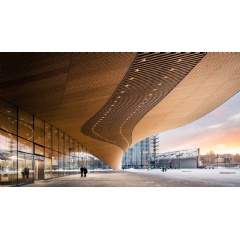Sustainable Buildings Are Becoming Mainstream but Still Low Awareness of the Benefits
Sustainability features increases the value of a property according to 64% of the 400 Nordic and UK based architects, developers, contractors and investors who participated in the 6th edition of the Sustainable Building Market Study.
Today, buildings are responsible for more than 40 percent of global energy usage, and as much as one third of greenhouse gas emissions. There are no quick-fix solutions for creating a more sustainable built environment. The ‘Sustainable Buildings Market Study’ aims to explore drivers, trends and contribute with market insight.
Sustainability is the new normThe study shows that sustainability is becoming mainstream in the sector, all the respondents were engaged in sustainable projects compared to 2017, where 5% stated that none of their current projects could be considered sustainable. Looking ahead more 57% of the respondents stated that they expected more than half of their future projects to be sustainable. However, the study reveals a lack of clarity regarding the costs and benefits of sustainable buildings. When asked if sustainable buildings are a good investment, close to 50% of all respondents have little or no insight if sustainable buildings cost more to build, if they have reduced operational cost or if they trade at a premium.
While return on investment is a key driver, Rikke Bjerregaard Orry, Ramboll’s group Sustainability Director for buildings, said “We anticipate an increasing interest from future generations in leading sustainable lifestyles, minimising their personal carbon footprint and working for companies that share their values and operate sustainably. Sustainable buildings tap into this trend and will increasingly become an identity marker for companies striving to make a difference”.
Innovation and digitalisationDigitalisation, innovative technologies and new construction techniques carry the promise of improving sustainability and efficiency in the construction sector. According to the respondents we can expect a wider use of Building Information Models (BIM) - not only in the design phase, but also in the operational phase and at the end-of-life-stage of a building. Creating a digital twin of a building makes it possible to consolidate different sustainability metrics, such as Life Cycle Assessment and Total Cost of Ownership into a single model, creating transparency and making it possible for the developer to base their decisions on more complete environmental and economical understanding.
The trend that respondents (49%) identify as the most important is: On-site renewable energy / distributed energy solutions – such solutions can include solar panels, district heating and provision of energy storage. Using new materials to increase sustainability and reduce carbon emissions is also seen to have a large potential. For example, Cross Laminated Timber (CLT) as trees grow they absorb carbon dioxide and store it until they decay or are burned. This makes timber a highly sustainable material. Furthermore, the material can be re-used at the end of a building’s life.
Measuring well-beingEven the most knowledgeable building owners and project teams benefit from accountability and clear direction. Survey respondents were asked to indicate the three most important issues that influenced their decision to use environmental certification schemes. The top three responses in 2019 were ‘Client, tenant or other stakeholder requirement’ (60%), ‘Enhancement of building performance’ (51%) and ‘Improved quality’ (44%).
Indoor air quality, lighting and thermal comfort are rated by the respondents as the most important wellbeing and health-related factors. Interestingly, few countries have mandatory thresholds for such wellbeing factors. However, environmental certifications standards such as DGNB, LEED and BREEAM can help address issues such as air quality, by dictating requirements to building materials with low levels of chemical substances.
( Press Release Image: https://photos.webwire.com/prmedia/5/241896/241896-1.jpg )
WebWireID241896
This news content was configured by WebWire editorial staff. Linking is permitted.
News Release Distribution and Press Release Distribution Services Provided by WebWire.
